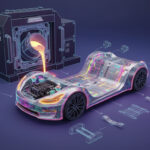Augmented Reality (AR) is transforming the way we interact with the world around us, blending digital content seamlessly into our physical environment. However, like any technology, AR is not without its challenges. One of the most critical issues faced in AR development is tracking errors. These errors occur when the AR system struggles to accurately position virtual objects in the real world. In this comprehensive guide, we’ll explore the various types of tracking errors, their causes, and effective strategies to mitigate them.
![]()
Types of Tracking Errors
1. Drift: Drift occurs when virtual objects shift or move from their intended position over time. This can be caused by a variety of factors, including sensor inaccuracies and environmental changes.
2. Jitter: Jitter refers to rapid, small-scale movements or vibrations of virtual objects. It can occur due to imprecise tracking data or interference in the AR system’s sensors.
3. Scale Inaccuracies: AR systems can struggle with accurately determining the size and scale of virtual objects in relation to the real world. This can lead to objects appearing too large or too small.
4. Depth Inconsistencies: Depth errors occur when virtual objects don’t align correctly with the real-world environment. This can lead to objects appearing to float in mid-air or sink into surfaces.
5. Loss of Tracking: This is the most severe type of tracking error, where the AR system completely loses track of its position and orientation in relation to the real world.
Causes of Tracking Errors
1. Environmental Factors:
– Lighting Conditions: Extreme lighting conditions, such as very bright or very dim environments, can affect the accuracy of tracking systems.
– Reflective Surfaces: Highly reflective surfaces can interfere with the tracking process, causing inaccuracies.
– Complex Backgrounds: Environments with a high level of visual complexity, like crowded or cluttered spaces, can pose challenges for tracking.
2. Hardware Limitations:
– Sensor Quality: The accuracy and precision of the sensors used in AR devices play a significant role in tracking performance.
– Processing Power: Weaker processors may struggle to process tracking data in real-time, leading to errors.
3. Software Algorithms:
– Sensor Fusion Techniques: The algorithms used to combine data from different sensors (such as gyroscopes, accelerometers, and cameras) can impact tracking accuracy.
– Feature Detection and Matching: Errors in identifying and matching visual features in the environment can lead to tracking inaccuracies.
4. User Movement and Interaction:
– Erratic Movements: Rapid or erratic movements by the user can challenge the AR system’s ability to maintain accurate tracking.
– Obstructions: Objects or body parts blocking the view of the sensors can disrupt tracking.
Strategies to Mitigate Tracking Errors
1. Optimize Lighting Conditions:
– Ensure consistent, moderate lighting to provide a stable visual environment for tracking.
2. Minimize Reflective Surfaces:
– Avoid environments with highly reflective surfaces, or take measures to cover or mitigate reflections.
3. Utilize High-Quality Sensors:
– Invest in AR hardware with high-quality sensors to improve tracking accuracy and reliability.
4. Calibrate Sensors Regularly:
– Implement regular calibration routines to ensure sensors are providing accurate data.
5. Implement Sensor Fusion Techniques:
– Utilize advanced sensor fusion algorithms to combine data from multiple sensors for more accurate tracking.
6. Provide Clear User Guidance:
– Educate users on best practices for movement and interaction to minimize disruptive behavior.
7. Continuous Testing and Iteration:
– Regularly test AR applications in various environments and conditions to identify and address tracking issues.
Tracking errors are a natural challenge in AR development, but with the right strategies and techniques, they can be effectively managed. By understanding the types and causes of tracking errors, and implementing best practices in hardware, software, and user behavior, developers can create AR experiences that are more immersive and accurate. As technology continues to advance, we can expect to see even more sophisticated solutions to further reduce tracking errors in the future.










